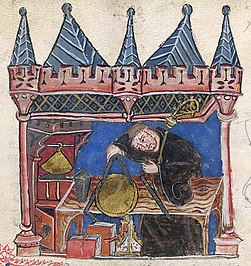Richard of Wallingford
| Richard of Wallingford | |
|---|---|

Richard of Wallingford is measuring with a pair of compasses in this 14th-century miniature.
|
|
| Born | 1292 Wallingford, England |
| Died | 1336 St Albans |
| Occupation | Astronomer, Horologist and Monk |
| Parent(s) | Father- a Blacksmith |
Richard of Wallingford (1292–1336) was a catholic monk and English mathematician who made major contributions to astronomy and horology while serving as abbot of St Albans Abbey in Hertfordshire.
Richard was born, the son of a blacksmith, at Wallingford in Berkshire (now Oxfordshire) in England in 1292. When he was orphaned he was taken to William de Kirkeby the Prior of Holy Trinity Priory. Richard subsequently spent 6 years studying at Oxford University before becoming a monk at St Albans. He later studied for 9 more years at Oxford. In 1327 he became abbot of St Albans.
Richard of Wallingford is best known for the astronomical clock he designed, while he was abbot, which is described in the Tractatus Horologii Astronomici (1327). The clock was completed about 20 years after Richard's death by William of Walsham but was apparently destroyed during Henry VIII's reformation and the dissolution of St Albans Abbey in 1539. His clock almost certainly was the most complex clock mechanism in existence at the time in the British isles, and one of the most sophisticated ones anywhere. The only other clocklike mechanism of comparable complexity that is documented in the 14th century is the astrarium by Giovanni de Dondi. It gave not just the hours and minutes of the day, but also the tide's ebb and flow as well as the motions of the sun and moon. Based on the 14th-century literary evidence still surviving in the 20th century, several scholars of horological history have tried to build recreations of Richard of Wallingford's clock. The best known of these was built by Haward Horological and for many years was displayed at the Time Museum (now defunct) in Rockford, Illinois; one was built by Eric Watson and is now in the Wallingford Museum, and one built in 1988 is located at St Albans Cathedral.
...
Wikipedia
